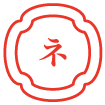Horiguchi Kiriko - Elevating the Art of Japanese Cut Glass
“The delicate characteristics inherent to traditional Edo Kiriko glassware is further elevated by Horiguchi Kiriko’s clear colours and refined patterns, which are meticulously hand-cut into the glass.”
Toru's Grandfather - Ichio Horiguchi
History of Edo Kiriko
Edo Kiriko was founded during the late Edo period in the old capital, Edo (now Tokyo). In 1834, glassware store worker Kyūbei Kagaya originated the craft of using garnet powder to cut and sculpt glass. Edo Kiriko has since developed into an intricate and sophisticated craft, gaining recognition as a traditional craft in Japanese culture.
Preserving Kiriko Traditions
Toru Horiguchi is a third generation master craftsman who comes from the Edo Kiriko tradition. In 1921, his grandfather Ichio Horiguchi trained under the Edo Kiriko master Kikuichi Kobayashi and became the first glass craftsman to earn the title ‘Shūseki' (秀石). As an honourable title that is bestowed upon the successor, this name is signed on to the finest quality Edo Kiriko glassware. Continuing in his grandfather’s footsteps to uphold Edo Kiriko traditions, Toru Horiguchi succeeded the title under the apprenticeship of second Shūseki, Tomio Suda.
Evolving Craftsmanship of Edo Kiriko
Horiguchi Kiriko was established in 2008 in a workshop located on the outskirts of Tokyo’s city centre. In shaping his own artistic identity, Horiguchi has infused traditional craft methods with contemporary values. While staying true to Edo Kiriko’s tradition, Horiguchi continues to push the boundaries of glass in order to gift it to the future generation of Edo Kiriko craftsmen. He explores new forms of expression - by way of shifting the focus from colourful designs to a more minimal and refined approach that is suited for everyday use.
Horiguchi has expanded the medium beyond tableware through various projects - from the production of large-scale light fixtures and professional tableware for Michelan Star establishments, exhibiting in art installations worldwide and collaborating with contemporary designers. He has also been active as a cultural ambassador for Edo Kiriko - going on tours throughout Europe to showcase the Japanese cut glass tradition. Through his efforts, Edo Kiriko has steadily established itself as an evolving craft that defies fixity.
The Workshop
Horiguchi can usually be found in his workshop with a handful of craftsmen - including Senna Misawa, an artisan maker currently training under Horiguchi. Working with a small yet, dedicated team allows Horiguchi to oversee the entire process and assure absolute quality of the Horiguchi Kiriko glass range. Horiguchi’s commitment to his craft is physically manifested - from the polished white workshop which can be likened to a laboratory, to the uniform he bears which he crafted for himself. Abandoning the old workshop style was a bold shift towards advancing the craft of Edo Kiriko.
The Art of Horiguchi Kiriko
The production of a single Edo Kiriko glass comprises of six crucial and labour-intensive steps. The first step, Waridashi, involves a process of marking the glass surface with vertical and horizontal reference lines, which act as a loose guide for all the cuttings. The basic cutting, Arazuri, shapes the foundation of the design. This is followed by Sanban-gake, the distinguishing element of the Edo Kiriko craft which entails a unique application of precise cuttings made onto the glass. Following the detailed cutting is Ishigake, which smooths the cut surfaces to make the piece more refined. Once the surface is smooth, the glass is polished in a process called Migaki, which heightens the lucidity of the cut surfaces. Finally, Bafugake or Buffing, reveals the true shine and transparency of glass.
The delicate characteristics inherent to traditional Edo Kiriko glassware is further elevated by Horiguchi Kiriko’s clear colours and refined patterns, which are meticulously hand-cut into the glass. The delicate subtleties and entrancing shadow play can transform the spatial experience in any given environment.
Philosophy of Horiguchi Kiriko
Horiguchi continues to challenge himself with unorthodox methods to elevate the craft beyond tradition. He is not afraid to make changes encompassing his understanding of contemporary culture, although these shifts are revealed over long periods of time and the emphasis remains on the importance of history and tradition. This has been a complex and lengthy process, with Horiguchi experiencing countless trial and error. However, this intensive process has given him an emotional bond to each of his pieces, and this personal relationship to each individual glassware is above all, the key element that drives the craft forward.








